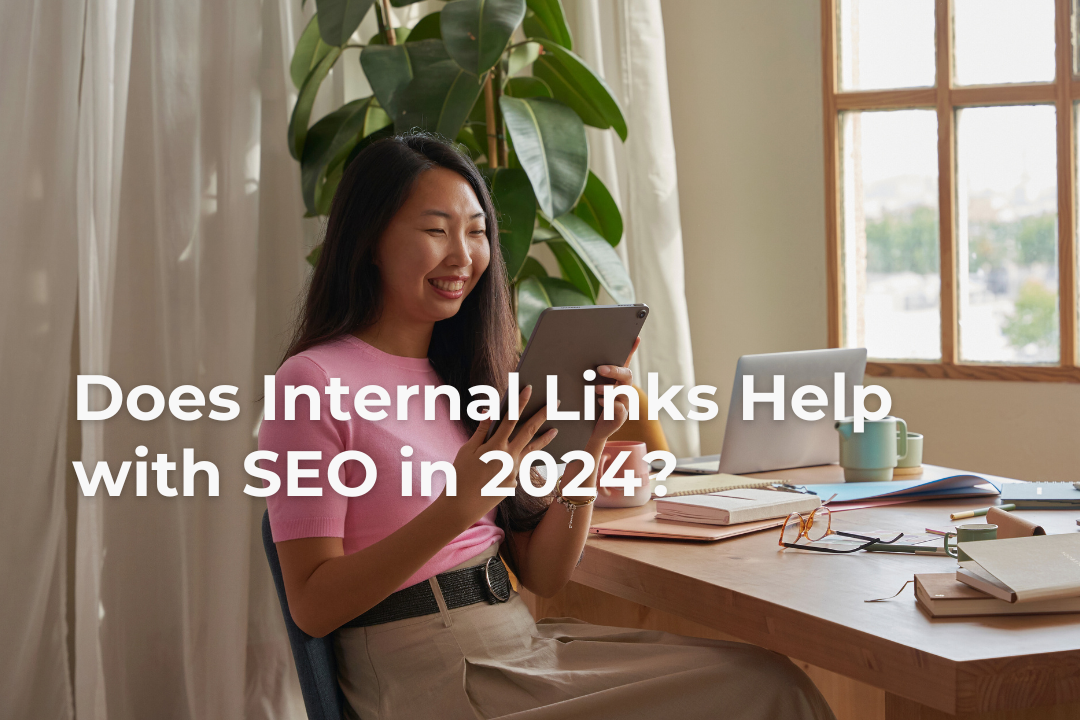Are internal links still useful for SEO in 2024?
Internal links help improve SEO. This is because internal links can help guide users and search engines through the website, allowing them to understand your website better.
If you’ve ever wondered why your website’s SEO strategy isn’t working as well as it should, or if you’re just starting out and want to build a strong foundation, then internal linking should be on your radar.
In this blog, we will explain what internal links are, how they boost your SEO, and best practices for using them effectively.
What are internal links in SEO?
Internal links are hyperlinks that point from one page on your website to another page on the same website.
Unlike external links, which lead users to different websites, internal links keep users on your site.
Think of them as the threads that weave your website into a cohesive whole. Whether you’re linking to your homepage, a blog post, or a product page, internal links help both users and search engines navigate your site.
For beginners, it’s essential to understand that internal links are more than just navigational tools. They’re a way to signal to Google what content is important on your site and how it’s all related.
When done correctly, internal linking for SEO can help distribute link equity (often called “link juice”) across your site, boosting the visibility of key pages.
How does internal linking help SEO?
1. User accessibility
Internal links are vital for guiding users through your site. Imagine landing on a blog post about SEO strategies. At the end of the post, you see links to related content, like “Best Keyword Research Tools” or “On-Page SEO Tips.”
These links help users discover more content that interests them, keeping them engaged on your site longer. The longer users stay, the more value your site provides, which can reduce bounce rates and increase conversions.
2. Google Search Engine's crawlabiity
Google’s web crawlers, known as Googlebot, rely on internal links to discover and index pages on your site. When you add a new page, Googlebot uses internal links to find and analyze it. T
he more logical and structured your internal linking strategy, the easier it is for Google to crawl and understand your site’s hierarchy.
By linking relevant pages together, you help Google understand the relationship between your content.
For example, if you have a blog post about “Content Marketing” and another about “SEO Strategies,” linking them tells Google that these topics are related. This helps Google index your site more effectively, improving your chances of ranking higher in search results.
How to improve SEO with internal links?
1. User navigation
Internal links are your users’ roadmap. They guide them through your site, helping them find related content and understand the structure of your site.
To enhance user navigation, link to relevant pages that add value to the user’s journey.
For instance, if a user is reading about “SEO Basics,” you could link to pages about “Advanced SEO Techniques” or “SEO Tools.”
2. Search engine crawling
As mentioned earlier, Googlebot uses internal links to discover new pages and understand their relationships.
To optimize for search engine crawling, ensure that your most important pages are easy to find.
This might include linking to them from your homepage or other high-traffic pages.
3. HTML best practices
When creating internal links, use proper HTML elements, particularly the “<a>” tag with an “href” attribute.
Avoid using non-standard elements like spans, divs, or buttons to create links.
These elements might not be recognized by search engines, reducing the effectiveness of your internal links.
4. Meaningful anchor text
Google recommends using descriptive, meaningful anchor text for links.
Anchor text is the clickable text in a hyperlink, and it should give users a clear idea of what to expect when they click the link.
For example, instead of using generic text like “click here,” use something like “learn more about internal linking strategies.”
This approach not only improves user experience but also helps Google understand the context of the linked page.
5. Balancing link quantity
While internal linking is essential, it’s crucial not to overdo it.
Adding too many links can overwhelm users and dilute the page’s focus. Instead, apply critical judgment when adding links.
Create logical connections between related content without turning your page into a link farm.
6. Technical considerations for links
Ensure your internal links are implemented correctly from a technical standpoint.
Stick to proper HTML structure, and avoid using non-standard elements.
This will help search engines correctly interpret your links, ensuring they contribute positively to your SEO efforts.
How much internal linking is too much?
Internal linking is vital for SEO, but how much is too much? The answer lies in balance and logic.
If a link adds value to the user and makes sense in the context, it’s worth including.
However, overloading a page with links can confuse users and potentially harm your SEO.
Google’s bots use internal links to understand the structure and hierarchy of your site.
A well-structured linking strategy signals to Google which pages are the most important, helping them rank higher in search results.
Think of it as passing “link juice” from one page to another, boosting the page rank of your internal pages.
To avoid over-linking, focus on the user experience. Link where it makes sense and avoid adding links just for the sake of it.
This will help maintain a clean, user-friendly site that’s easy for both users and search engines to navigate.
How long does it take for internal links to start improving SEO?
One common question is how long it takes for internal links to impact SEO. The answer varies depending on several factors, including the importance of the page you’re linking from.
For instance, links from high-traffic pages like your homepage might be picked up by Google quickly, leading to faster indexing and improvements in SEO.
On the other hand, links from deeper pages in your site’s architecture may take longer to be noticed by Googlebot. This is why it’s essential to ensure that your most critical pages are easily accessible via internal links.
While some improvements might be noticeable within a few weeks, it’s important to remember that SEO is a long-term game, and consistent internal linking will yield the best results over time.
Conclusion
Internal links are a crucial part of improving website SEO.
By giving Google links to follow along with descriptive anchor text, you can indicate to Google which pages of your site are important, as well as what they are about.
To summarize:
- Internal linking improves user navigation and search engine crawling.
- Use meaningful anchor text and follow HTML best practices.
- Balance the number of links to avoid overwhelming users.
- Expect SEO improvements from internal links over time, depending on the page’s importance and crawlability.
At Pillars Media, a digital marketing agency in Malaysia, we understand the importance of a solid internal linking strategy. We’ve helped global clients enhance their SEO, and we can do the same for you.
Schedule a digital marketing consultation with us today and let’s optimize your site for success!

